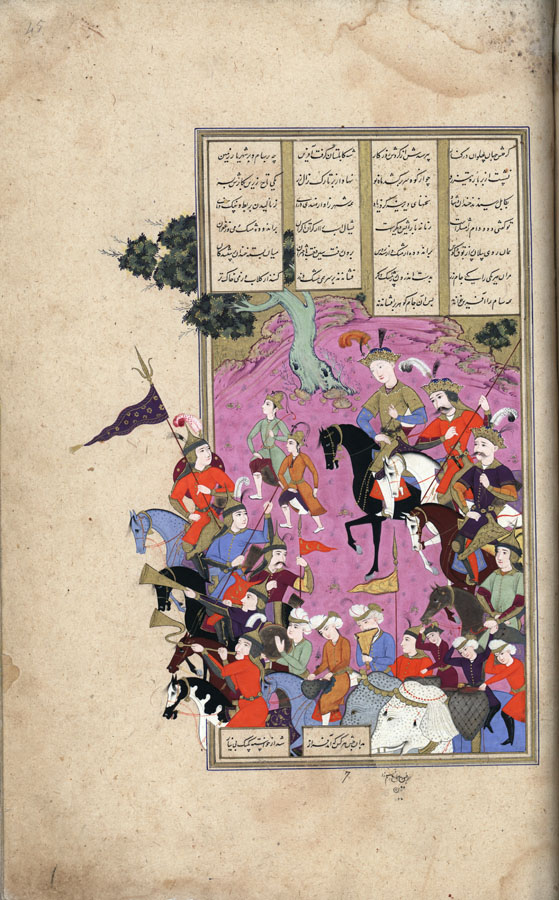Zāl Meeting Merāb of Kabul
The accompanying text is not specific enough to permit identification of the precise episode the painting represents without seeing the text on the adjoining folios. Welch has cataloged it as “Zāl and Mehrāb on Their Way to Visit Sām”, but one might be skeptical of this identification, for no sequence comes to mind when Zāl and Mehrāb jointly travelled to see Sām. The text also speaks of the arrival of the procession at Kabul, suggesting that it is rather Zāl’s first approach to that city and his initial meeting with Mehrāb..
The composition consists of a multitude of figures arranged in a circle that moves in a leftward direction. Largest in scale, at the top center, is the young white-haired Zāl astride a prancing black horse. To his left, at approximately two o’clock on the circle, are two personage which by their hieratic size and dress are of higher rank than the remainder of the procession. Both are mustached and wear crown-like head gear similar to Zål’s. Although Welch might identify one as Mehråb, it seems just as likely that these two individuals are close advisors of Zāl. The remainder of the circle is composed of an array of individuals that include grooms, elephant drivers, musicians, trumpeters, and soldiers. Hieratic scale is quite evident. The smallest, are the two grooms marching in the upper left, and the elephant drivers in the lower right. Their stature is about half that of Zāl. In between these two extremes are other sizes, ranging from the musicians in the left foreground, who are slightly larger than the grooms, to the soldiers and trumpeters on the far left who approach the stature of Zāl. The barren, sloping mauve hillside, which serves as a setting for the procession, rises to a rocky crest, and near the top a single windblown tree spreads its foliated branches behind the text blocks.
There are four columns of text above the painting. Two columns are comprised of seven lines, the other two of six lines each. A single line of two column text appears on the bottom left and evens off the total number of lines on the page. Four horses and their riders, a standard, and the branches of the tree exhuberently overlap the frame on the left side and protrude into the margin. The painting is signed and dated in the lower margin, in miniscule characters in Moʿin’s hand: ze towfiq s̱anʿe raqam zad moʿin (Drawn with the grace of the Maker by the most humble Moʿin), and the year 1065/1654-55.
Painting references:
Welch, AK4_1978, p.89, Ms.22, folio 45v [sic] (not illustrated).
Probable text reference:
Warner, I, pp.256-58; Mohl, I, pp.188-92.
Robert Eng
Last Updated: June 2, 2011 | Originally published: June 2, 2011
